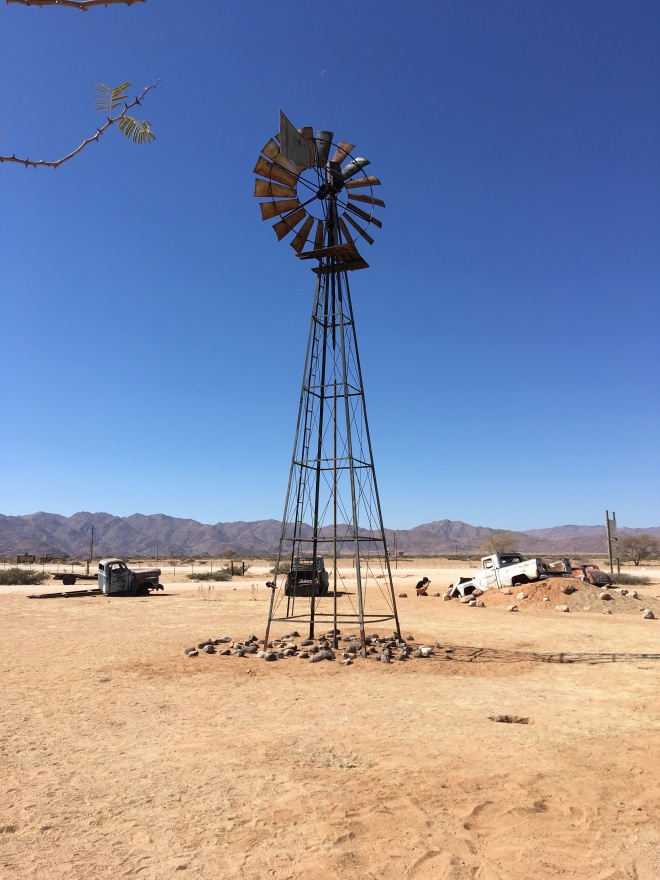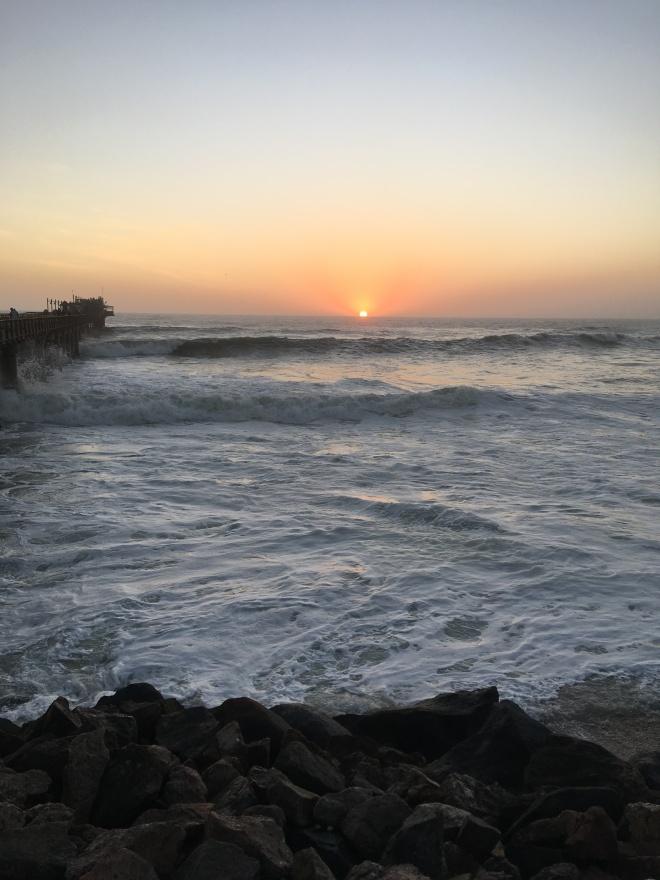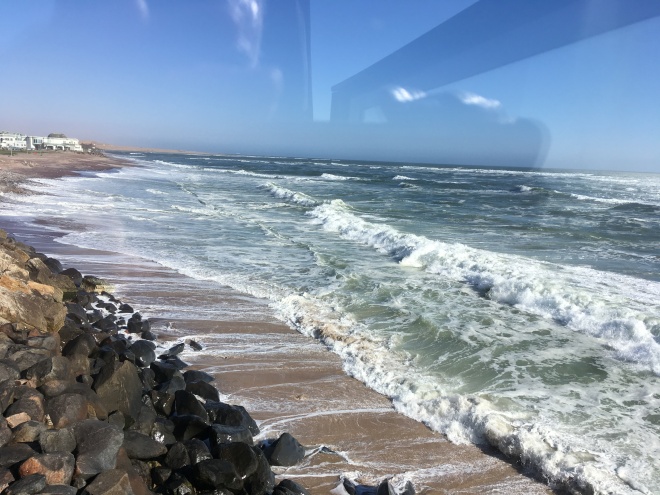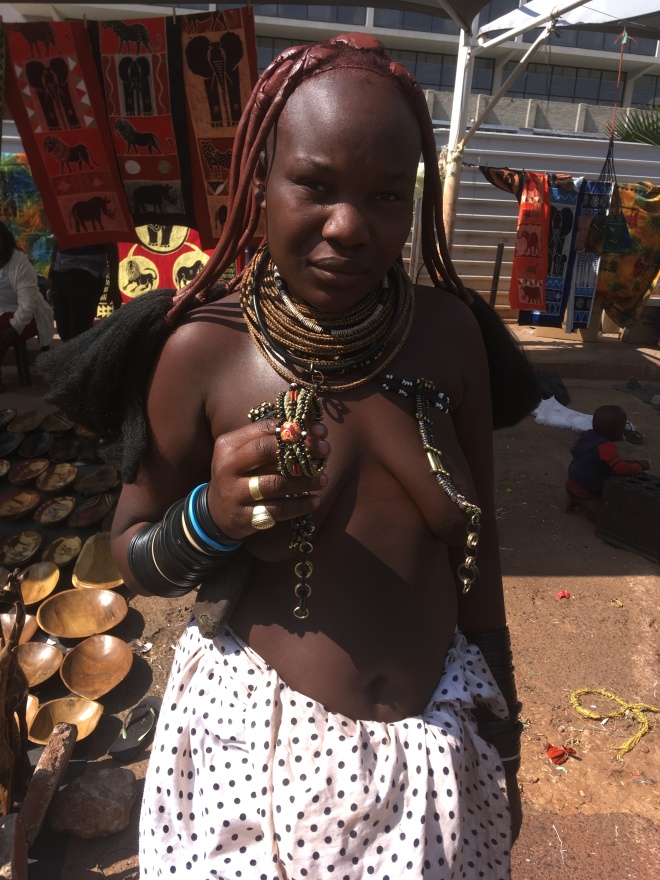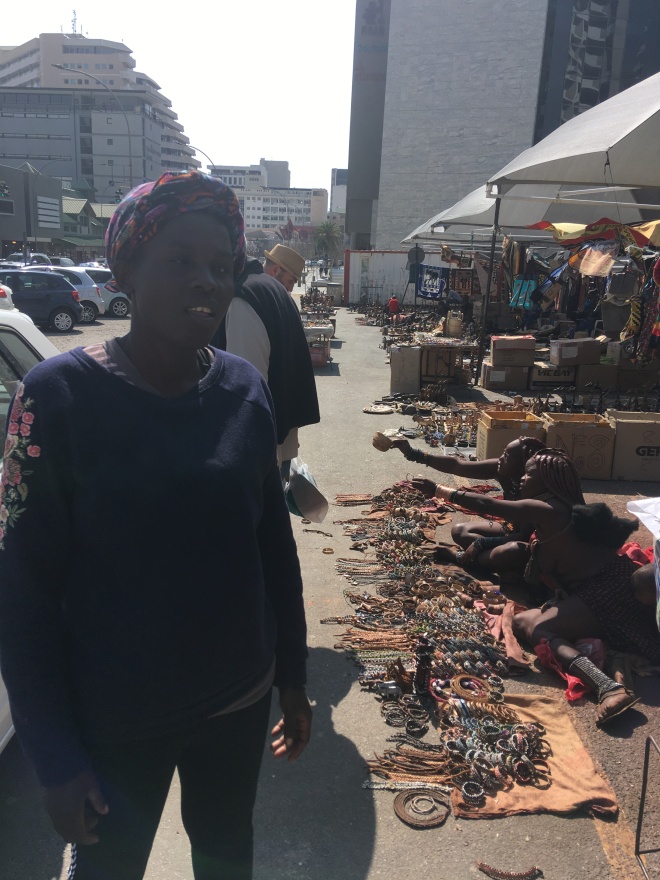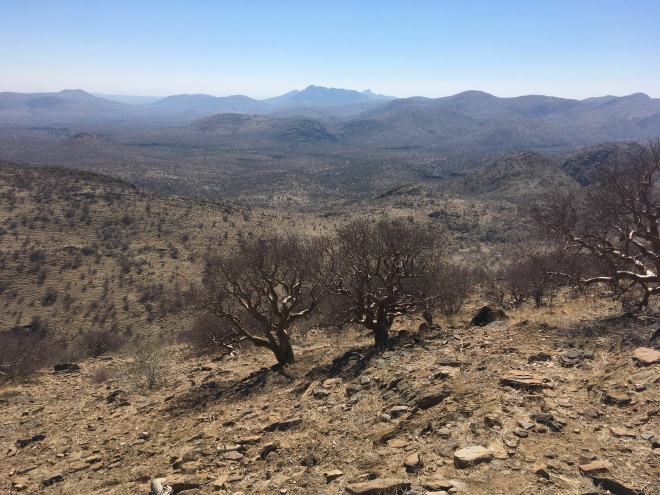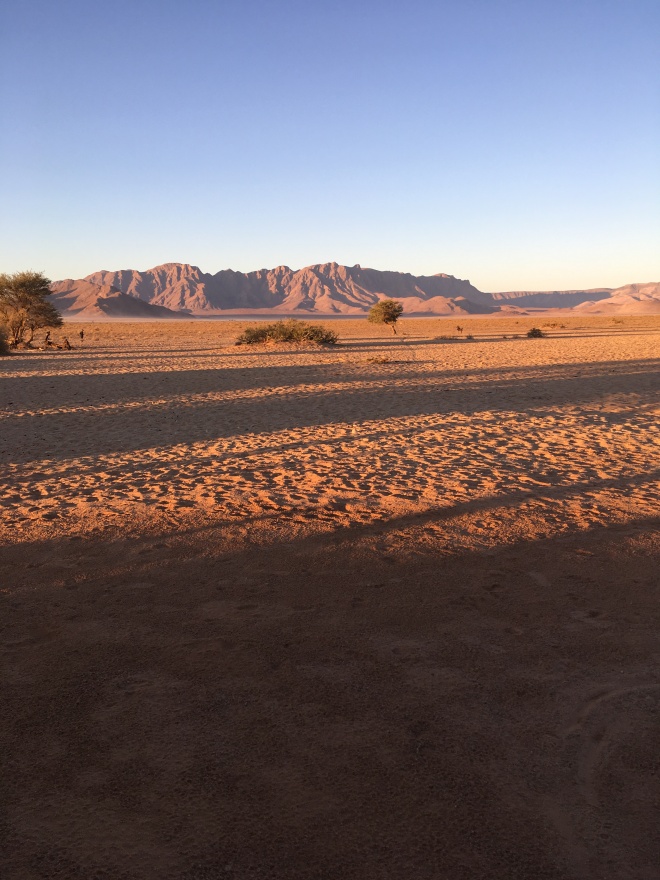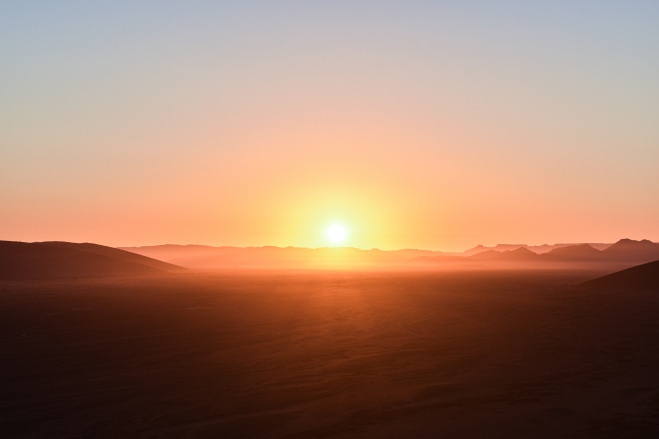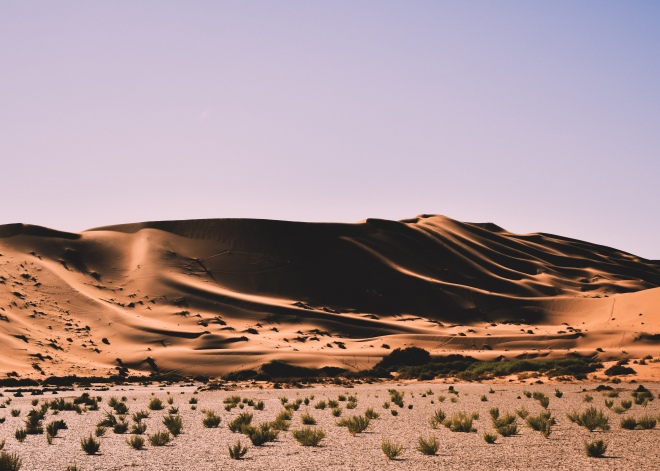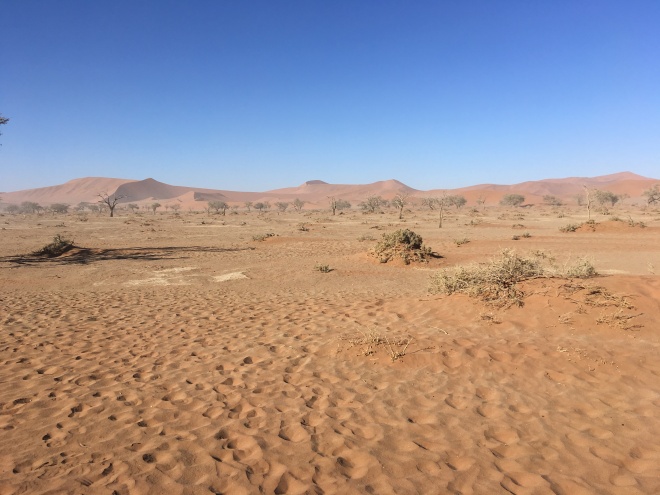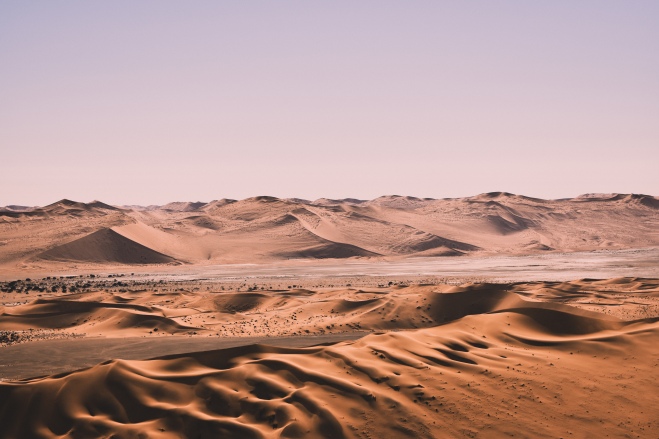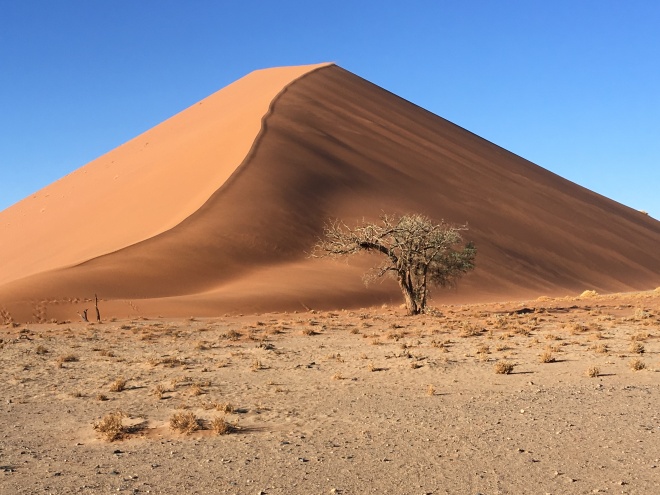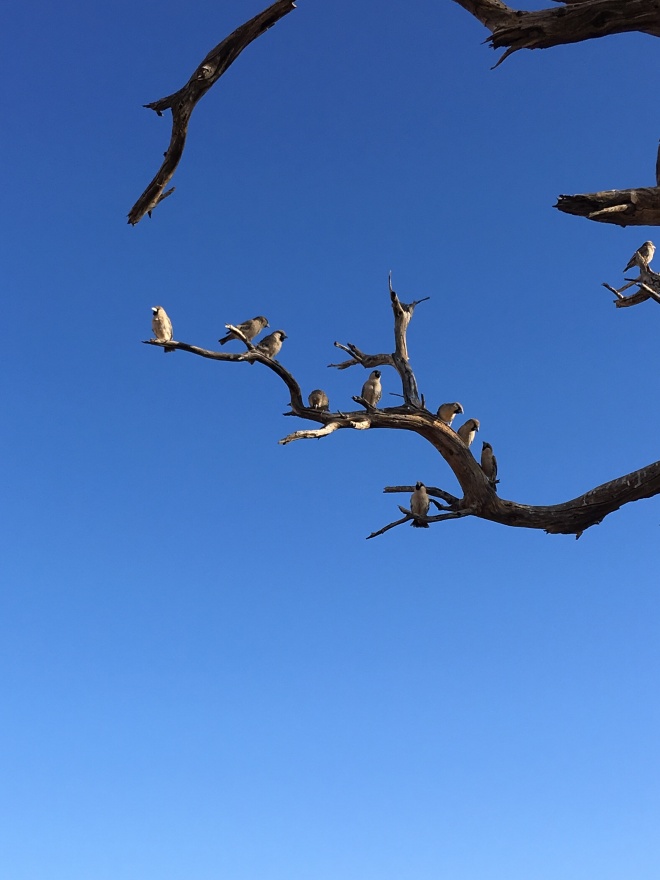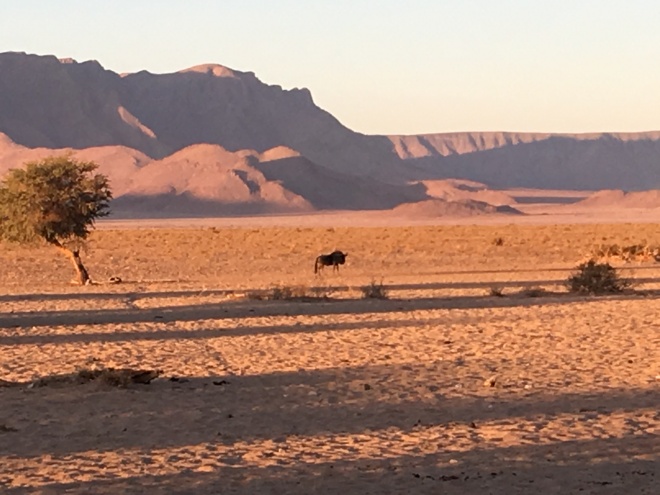…By dark we were back at the park boundary and went into a place known for its smorgasbord breakfasts, lunches, and dinners. It was an exquisite place. I have never been to an All-You-Can-Eat dinner that served such incomparably good food. I am not surprised that this place presented itself because for the most part, I have never traveled to a country that served so much meat, in such a wide variety, as Namibia. Meat was their piece de resistance. We serve steaks. They serve slabs of meat as thick as Oxford dictionaries. We serve beef. They serve every wild kind of browsing and grazing beast and more: Kudu, oryx, gemsbok, zebra, springbok and for good measure, warthog, though for some inexplicable reason I found myself shying away from animals of the wild. And I am only touching the surface. And then they had their sea food table, and the salads, desserts, vegetables, exotic fruits, each in their own room or at the least, station. And the meat was in the form of rib eyes, T-bones, sirloins, ribs, you name it. And at every station was a chef roasting, and then subsequently dishing out the diner’s every wish. And every diner’s table was out, under the stars of a southern hemisphere sky. I felt rich if not completely famous. Things were finally settling in and the trip was smoothing out as we approached our departure date. Up until this point, the entire trip had felt a little like Mr. Toad’s wild and crazy ride.

So we ate our righteous fill and afterwards drove back to our immaculately shiny and orderly little room, resplendent in space relative to every night on the trip prior to this moment. The silence was incomparable, muffled by the great dunes, the cool of winter on the Tropic of Capricorn, and the isolation—the kind of place where you knew you were far, far away from anything like home. Those are the moments that make travel a sublime experience. We had a full day ahead of us and we had to get a reasonably early start the next morning to beat the inevitable line that would be itching to enter the park boundary and head for…. wherever that road was supposedly taking us. I still had not put two and two together and thought we were just going into an area renowned for its majestic and superlative red dunes. It was all nice, but I still was not thinking of the petrified Sossusvlei.
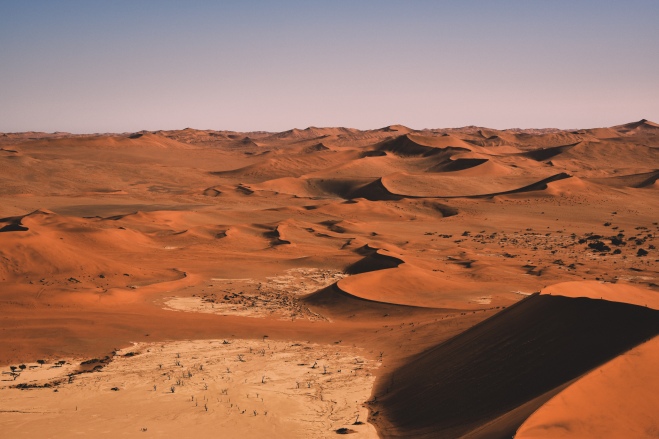
Morning came crashing down on us like unremitting sin. I am a night person and since I have been retired my nights have become progressively later and have transmogrified into the vampire killing pale of late day. Please don’t force me up early. But Don was a terribly early riser anxious to find his coffee and Sierran could get up early if the need was there so I really had no choice. I disdained leaving the comfort of our lodging at such an unforgiving hour as sunrise. But as we glanced out our cottage’s front window, it was obvious that the many Dutch travelers knew it was better to be early rather than late, so we were soon in line at the park entrance, cussing at being so far back, thinking about the disadvantage we now faced, being slow to start. But once in, how great it was being on a newly paved road. What a welcome relief to escape the brutal beating of that washboard of a road that had brought us to the back country.
The dunes got more orange and steeper, the plant life more sparse and alien-looking, and Sossusvlei more inimitably foreign. I can’t imagine what the first European explorers must have thought as they pushed through this region to the southern Atlantic. Even native Africans, the Sans bushman, must have found this region to be daunting for the lack of water and the slow going the endless dunes must have created. But I don’t know; the Sans people seemed to be able to survive any arid land.
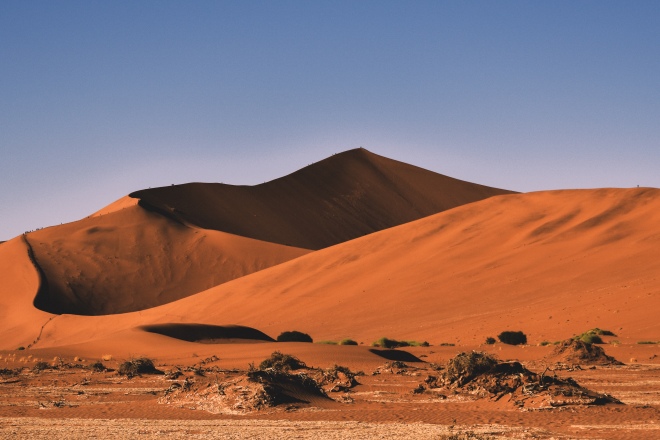
We ventured here and there, exploring surrounding dunes, but I still was not sure what Sierran had in mind. I kept thinking he wanted to climb a dune, but nothing really glared at me. When we reached the end of the road, there was a dune that stood out in its uniqueness. From a distance, it looked like a mighty line of ants was pushing up and out of sight of another dune, then reappearing on the ridge, headed for the top of this particular dune. This was Dune #45 and I pointed it out to Don and Sierran. Maybe this was where we were headed? Everyone seemed headed up that dune and I thought to myself there was no way I was going to climb it—I saw no real purpose to putting myself to a grueling test of endurance for maybe 3 hours when in fact, I was absolutely not dressed for such a hike, not to mention I had no water with me—-just to stand at its top spitting cotton balls for lack of hydration. The pavement ended at a large dusty area that was a parking lot and Sierran swung the VW in and miraculously found a parking spot. There was some kind of a transport vehicle everybody was standing around anxious to board, open sided with enormous wheels for navigating its way across banks of dust and rolling ridges of sand. I still had no idea where everyone was going, but now I began thinking they must be headed to the base of these dunes where they would all commence to climb Dune #45.
We lingered about the transport vehicle and Sierran reappeared with “tickets” he had purchased to wherever it was going. Things were happening kind of fast. Before I knew it, we were on our way, somewhere, I knew not where. After a few km it stopped and everybody climbed off and we joined the crowd walking in a dense line north. “What are we doing?” I thought. Don hung like a shadow next to Sierran. I asked him where he thought everyone was going and he replied he didn’t know, but he was determined to stick as close to Sierran as possible trusting as usual, Sierran’s judgement. I thought to myself that there was no way Don would be able to climb Dune #45 if that was where they were going. “Are you nuts?” I thought.
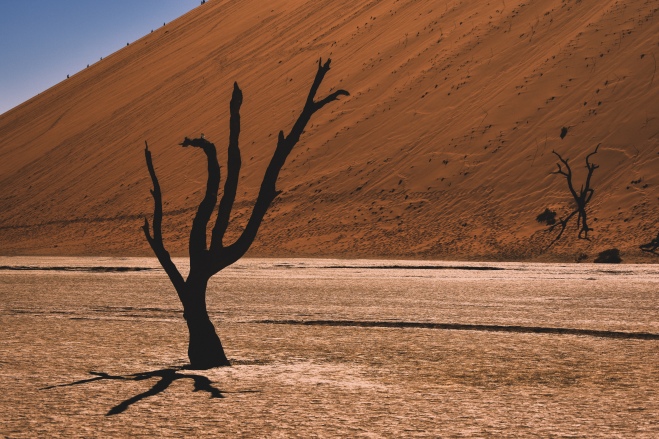
A few hundred meters up the trail I stopped Sierran, utterly mystified by all that seemed to be going on, though I seemed to be the only person in that queue that had not one clue to where we were all going, let alone why, and told him, “hey, you go on without me; I’ll wait for you guys down here”. Sierran looked at me a little funny and said, “ok”. And they continued. I walked back down the trail, found a spot in the shade of one or two dead desert trees, and parked myself. From there, I just watched people, by the hundreds, walking in an endless stream, out of sight. Then much later the same stream would re-appear on Dune #45, though it appeared in much smaller numbers, trudging slowly, climbing, climbing, and I wondered to myself how so many people at the base of the hike seemed to vanish from the flow as it later reappeared on the ridge going up Dune #45. Perhaps it was just the distance and it only appeared the higher the line of people climbed, the leaner the line appeared to get. It had to be the challenge of the hike that was breaking the line of people down, kind of like at a certain point, it came down to every man for himself. I was mystified. But I was too far away to really understand what was transpiring with the hikers.
There were plenty of people older and in worse looking shape than myself pushing out of sight, apparently headed up the side of that monstrous dune. Where were they all going? I kept thinking to myself that there was no way Don was going to be able to keep up with Sierran, but I figured that would work itself out.
In the meantime, I started playing around and I spotted a gecko, which I finally caught. I began entertaining myself with my own little distractions, taking photos, observing various things, but of course, all the while wondering about where people were going. Then about 1 1/2 hours later I spotted Sierran and Don coming back and I went over to intercept them. I joined their company, got back on our transport vehicle that took us back to the “parking lot” where we then had the rest of the day to take our long ass ride back to Windhoek.
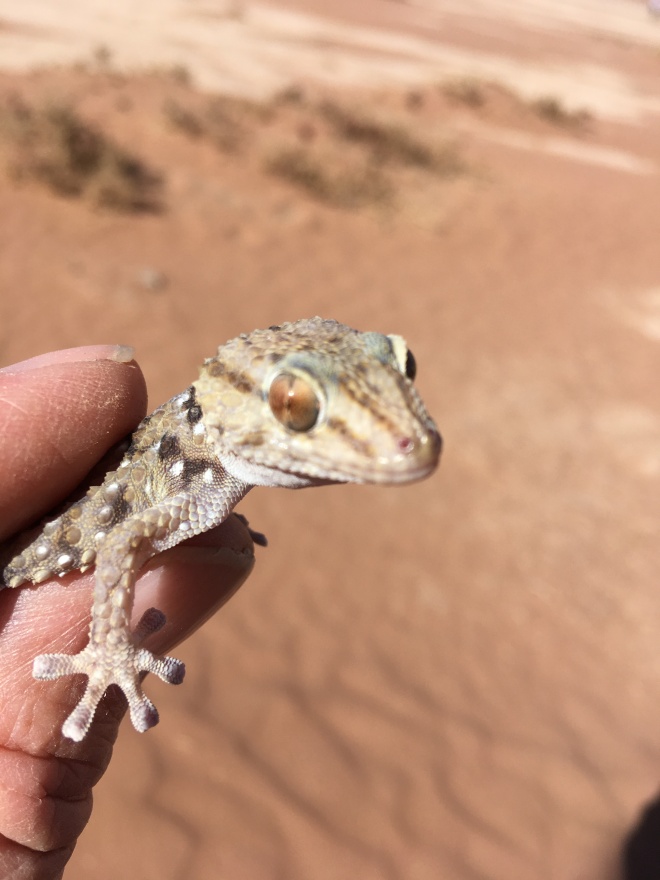
I really was dying to know what they had done because things were not adding up. They got back at least an hour before I expected. I finally asked Don where they had gone. He casually said “Sossusvlei”, meaning the place that people come from all over the world to see, the petrified trees in the flat white pan surrounded by the iron oxide dunes. I didn’t think I heard him right. He was talking about the holy of the Holy Sossuvlei; I am sure that is what he meant—the Sossuvlei everybody who travels to Namibia wants to see. It was the most epochal view that part of Africa had to offer. It was more than a view—it was an experience that magically made time stand still! I don’t know how describe it because it is one of those experiences that goes beyond words. You don’t intellectualize it—it just IS!
Sierran elaborated. Yes, they had spent nearly 2 hours in that pan taking cell phone photographs, registering epic sights, gawking in awe at the preternaturalness of this lonely nook that may as well been on the dark side of the moon, frozen in a once-in-a-lifetime moment, and finally finding a little area where there was no one, and they had it all to themselves! And what the F was I doing? Sitting 400 yards away just out of sight—400 yards from one of the most iconic places in the faraway land of wild, dark Africa, a spot that ranked up there with the splendor of Victoria Falls, the might of the Pyramids of Giza, or the forlorn shore of Tanganika in Ujiji where Stanley met Livingston! And me, what was I doing a mere 400 yards away? Playing with a f***ing palmato gecko! Twiddling my thumbs, Aaaurrghh!! If I understood correctly, and I thought I did, I wanted to scream.
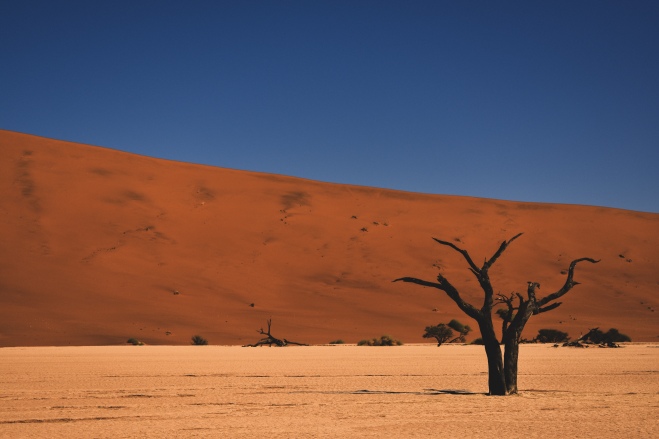
I tried to keep my composure. I asked Sierran why he did not tell me that that was where he was headed. He said he thought I knew.
“Why did you think I headed back, if I knew?”I asked.
“I don’t know,” he said. “Because you were tired?” He was surprised but of course it was not like him to ask why I would not have wanted to see that sight being a mere 400 yards’ stroll away, to gaze in amazement at a sight people will go half way around the world to see, kind of like the statue of Liberty or the Eiffel Tower—-maybe I was too tired?! So he had said nothing but “okay” (see you when we get back). Don didn’t know either, but he doesn’t ask questions—he was just going to go, trusting that that would be the wisest decision. And evidently it was.
At that moment, my anger erupted. A volcano of sordid filth spewed forth from somewhere in my gut that I guess must have been hidden in the core of my being, I shamelessly confess now. I had not been so angry in years. Everything I must have been harboring for months, or even longer, exploded. I exploded with the most vulgar vituperations my soul could muster. I was so f***ing crazy with anger and frustrations and cussed a mighty blue streak up one side and down the other at both Don and Sierran. The anger seemed so convoluted. It had to do with SO much, including, if not most of all, myself. My eyes went crossed and my blood pressure shot through the roof of that f*cking Volkswagon. I think I went insane. I had gone half way around the world and came within 400 yards of the most famed place in Namibia, the quintessential sight of southern Africa— within 400 yards!—, AND DID NOT SEE IT! I was crazed. Sierran just sniggered—that was his way of dealing with it. I couldn’t have expected anymore. And I am sure that if someone asked him about the whole affair, he could reasonably explain his part in it—and it would be more than acceptable. “How do I know what dad is thinking if he doesn’t say?” Maybe he was right. And then, to add insult to injury, Don threw in his two bits and gave me a brief lecture about how I needed to take more responsibility and this was all my own fault.
I carried on for about 10 minutes. If I could have detonated a nuclear bomb, I probably would have. It was the emotions that put people into prison. It took about 10 minutes for all my venom to be released. I could have been pissed for days, brooding profoundly for just as long, but then I realized that I just had to let it go. Nothing in the whole world would or could change anything that had happened. I could be angry for days if I chose, but why lose so much time, why simmer in the dark if I could somehow take a different perspective on it all, climb out of the dark of my anger, because after all, in the end it just boiled down to a perspective.
The more I thought about it, the more I realized that there probably isn’t a thing in the world we say, we do, we think, that isn’t the result of something within us about ourselves. Maybe as humans we just don’t know how to go deep enough to see the truth. And it is not simple behavior. The Truth may be simple once it becomes a part of us, but getting to that Truth is a long and winding road. I felt a deep sadness for my ignorance, and maybe the ignorance of our condition. Then I felt a chuckle somewhere in my gut. How ironic! What a lesson! Oh, how all of that had hurt. And I realized that I just had to let it go. Nothing in the whole world would or could change anything that had happened. I could be angry for days if I chose, but why voluntarily surrender so much time to ignorance. I don’t know exactly why, but then, oddly enough the whole ironic fiasco seemed a little humorous, as though it had happened to somebody else, which I am sure, would have made things so much easier, would perhaps have made me snigger a bit though I hope not. It just happened to be me.
It was not long before we were back on the washboard of a road, calmly enjoying the changing scenery and most of all, the constant glances of exotic wild life as we sky rocketed along the rag tag dust of some real desolate road. But something seemed wrong, it had been well over an hour since we had passed or had even seen the last vehicle on the road. We had gotten gas in Solitaire pictured below, the one and only community in the back country, population maybe 35, and we thought we had taken the correct turn towards what would eventually lead us to Kalkrand, civilization. But something was amiss…all these back roads looked the same, but nobody was on them…
